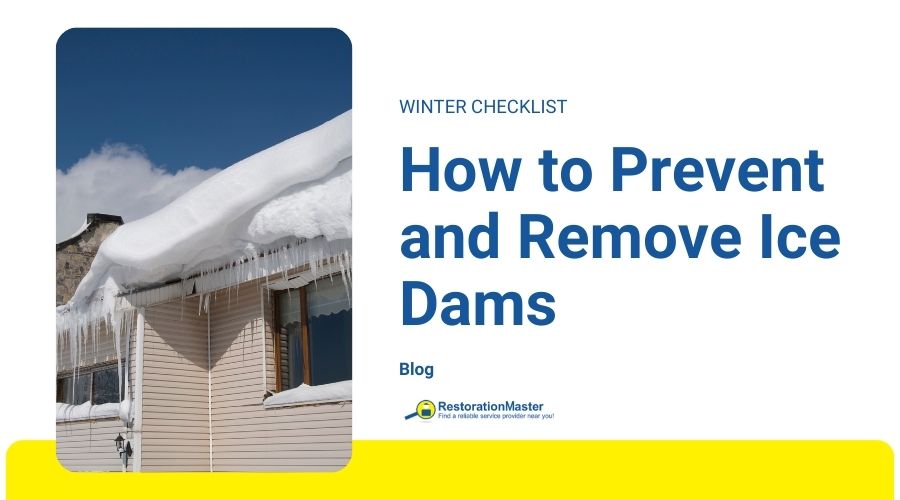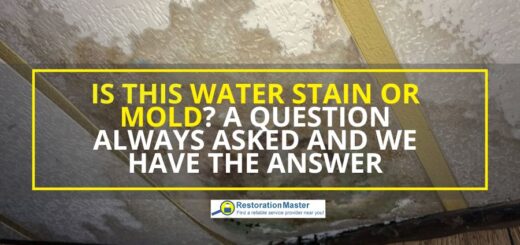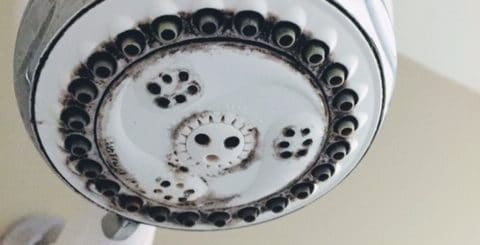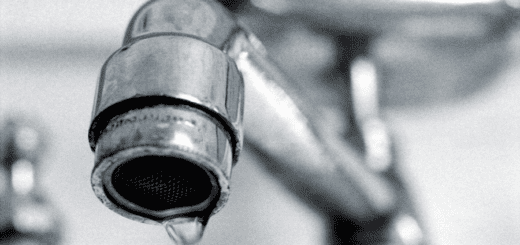Ice dams are an unavoidable reality for many homeowners during the winter, particularly at the start and end of the season. These icy formations can
leadLead is a heavy metal that can be toxic to humans, especiall... More to significant damage if left unchecked, making them a common concern in colder climates. States with severe winters, such as Minnesota, Illinois, Wisconsin, Michigan, and the mountainous areas of Colorado and Utah, often see a higher incidence of ice dams. To safeguard your home, it’s essential to understand what ice dams are, how they develop, and the best strategies for
preventionPrevention refers to actions taken to reduce the likelihood ... More and removal
What is an Ice Dam?
An ice dam is essentially a thick ridge of ice that forms along the edge of a roof, blocking the melted snow (which turns into water) from draining properly. As the water gets trapped behind the ice dam, it can start to back up under the shingles. This trapped water often seeps into your home, damaging things like walls, ceilings, and
insulationInsulation is a material used in buildings to reduce the tra... More. While it might seem like a small issue at first, ice dams can quickly lead
Lead is a heavy metal that can be toxic to humans, especiall... More to much bigger problems—like
moldMold is a type of fungus that grows in damp or humid conditi... More,
wood rot, and expensive repairs—if they’re not dealt with quickly and effectively.
How do Ice Dams Form?
Ice dams form when the roof over the attic gets warm enough to melt the snow on it. This meltwater runs down the roof until it reaches the colder eaves and begins to refreeze. As this process repeats, the ice at the eaves builds up and forms a dam, trapping more meltwater behind it. Here’s a detailed look at how this process unfolds:
- Heat Loss from the House: Warm air from your living space rises and escapes into the attic. This heat loss can occur due to poor insulationInsulation is a material used in buildings to reduce the tra... More, air leaks, or insufficient ventilationVentilation is the process of exchanging or circulating air ... More.
- Roof Warming: The escaped warm air heats the underside of the roof, causing the snow on top to melt.
- Water Flow: The melted snow (water) flows down the roof underneath the remaining snow cover.
- Refreezing at Eaves: When the meltwater reaches the colder eaves, it refreezes, forming a ridge or dam of ice.
- Water Backup: As the ice dam grows, it traps more water behind it. This trapped water can seep under the shingles and into the roof structureStructure refers to the framework or components of a buildin... More, leading to leaks and damage inside the home.
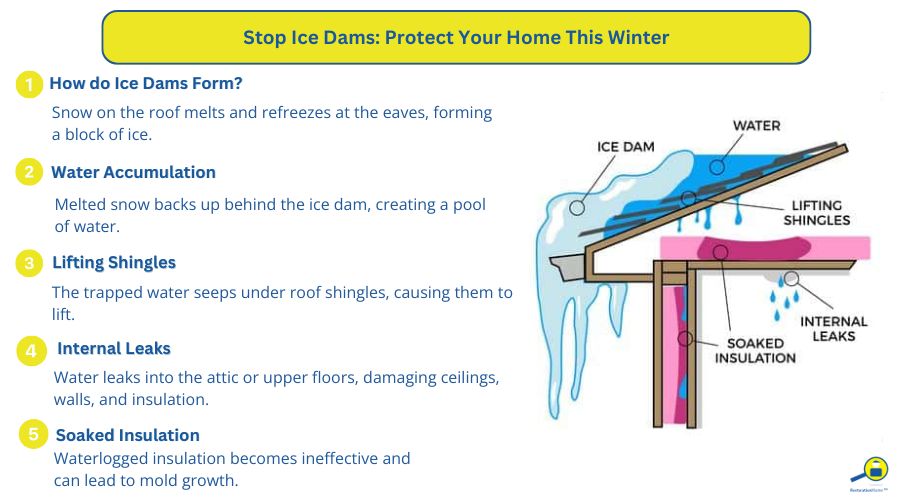
How to Prevent Ice Dams?
The best time to prevent ice dams is now, before winter hits. Here are some tips on how to prevent ice dams to your home.
Prevent warm air escaping through the attic
The average home loses 1/3 of its heat through the attic. The majority of it is caused by air leaks from unblocked walls, drywall gaps, cracks in light fixtures, chimney, pipes, access hatches, and other ceiling fixtures. When heat escapes through the attic, it warms up the roof and melts the snow and ice that then create ice dams.
While air leaks are tough to patch, you can pull or rake back the insulationInsulation is a material used in buildings to reduce the tra... More in your attic and plug the leaks with caulk or foam. Low roof angles can also make some air leaks difficult to reach, but only work on these areas during cooler temperatures as it can get hot when working. Also don’t forget to wear a long-sleeved shirt and long pants to avoid skin irritation from the insulationInsulation is a material used in buildings to reduce the tra... More.
Measure your attic insulation level
Check the depth of the insulationInsulation is a material used in buildings to reduce the tra... More in your attic. Standard codes require 12 – 14 inches of fiberglass or cellulose, but if you have less than 8 inches and have noticed ice dams in the past, adding more is an easy fix to your problem.
Add roof and soffit vents
The ventilationVentilation is the process of exchanging or circulating air ... More in your attic pulls in cold air from outside and pushes out warm air, cooling down the attic and roof. The minimum size of the openings should be one square foot for each 300 square feet of the ceiling area, when half the vent area is low and the other half is high. Installing the roof and soffit vents can also be very complex, so it’s recommended to have a professional handle this task.
Install IC rated Light Fixtures
InsulationInsulation is a material used in buildings to reduce the tra... More contact, or IC light fixtures are used in insulated ceilings to prevent the risk of excess heat flowing to the attic as well as fires. Use these to decrease the amount of heat passing through your attic.
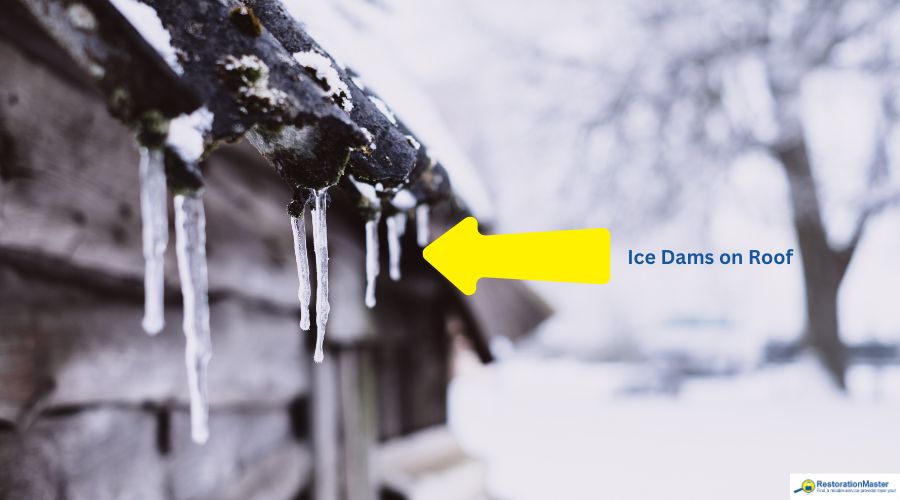
How to Remove Ice Dams?
While it’s best to prevent ice dams from forming on the roof, don’t hesitate to take action and remove them. Just don’t try to remove them yourself with a shovel or hammer as this can be both dangerous and result in additional damage to the roof.
Check out the following tips for removing ice dams from your roof:
- Use Cold Air: Introduce cold air into the attic by putting a box fan under the leaking area of the roof so that it blows cold air to the area and encourages the water to freeze.
- Use a Roof Rake: Using a roof rake, you can remove both ice and snow from your roof. These rakes are designed with a long handle and wheels to allow you to rake your roof while standing safely on the ground. Most roof rakes are also made from aluminum and shouldn’t damage your shingles. For homes that are two stories, it is recommended to hire a snow removal professional to address areas that are too high to reach when standing on the ground. Never climb up on the roof to remove snow with a shovel.
- Use Deicer: Deicers are used to melt some of the dam and create a path for water to flow off the roof. An effective way to create the path is to add calcium chloride deicer in a paint hose, laying it across the ice dam so it hangs over the gutter. The path allows the water to flow into the gutter and away from the property for proper drainage.
- Avoid Chipping the Ice: Never use a sharp tool to chip away at the ice. This can damage your shingles and make the problem worse.
- Call a Professional: If these DIY ice dam solutions do not remove the ice dam, you can call a professional that provides ice dam removal services. These professionals use low-pressure, high temperature steam that effectively melts the ice without causing damage to your roof or gutters.
Water Damage Restoration
If you’ve already noticed signs of water damage inside your home, such as in your attic, walls, or ceilings, it’s important to reach out to a
water damage restoration specialist and a professional experienced in removing ice dams. These experts are available around the clock to address water damage caused by ice dams.
Once they receive your call, they’ll quickly arrive with the necessary equipment to handle water extraction and restorationRestoration is the process of returning a property to its pr... More. Whether it’s dryingDrying is the process of removing moisture from materials, s... More out the affected areas or removing damaged materials, they will work efficiently to restore your home to its original state. If personal items like storage boxes or valuable artwork have been impacted, they will take the necessary steps to clean and dry them, minimizing permanent damage.
Additionally, to prevent moldMold is a type of fungus that grows in damp or humid conditi... More growth—which can start in as little as 24 hours—they will apply anti-microbials during the dryingDrying is the process of removing moisture from materials, s... More process.
Lastly, these professionals will coordinate with your insurance company to help streamline the claims process, ensuring you have one less thing to worry about.
Frequently Asked Questions
Gutter guards can potentially contribute to ice dam formation, but it’s not necessarily a direct cause. The main purpose of gutter guards is to prevent debris, like leaves and twigs, from clogging gutters and downspouts. However, if they are not installed properly or if certain types of gutter guards are used, they can inadvertently contribute to ice dam issues.
Here’s how it can happen:
- Impeded Water Flow: Some gutter guards can restrict water flow, especially if they’re designed with narrow or small openings. In the winter, when snow melts on your roof, the water needs to flow freely through the gutters and down the downspouts to prevent ice buildup. If gutter guards obstruct this flow, the water may get backed up in the gutters and start to freeze, contributing to the formation of ice dams.
- Trapped Snow and Ice: If the gutter guards aren’t properly angled or sealed, snow and ice can accumulate in the gutters. This can prevent the gutters from draining efficiently, causing water to collect and freeze. Once the ice builds up at the edge of the roof, it can form an ice dam, trapping even more water behind it and potentially leading to roof damage
- Improper Installation: If gutter guards are not installed properly, they might not provide the intended protection. In some cases, they can even block the water from draining out of the gutters properly, causing water to pool and freeze.
- Material Considerations: Certain types of gutter guards, like those made of mesh or plastic, can accumulate ice or snow more easily than others. If these materials are exposed to freezing temperatures for long periods, they can contribute to the formation of ice dams by holding onto frozen moisture.
Roof raking can help prevent ice dams to some extent, but it’s not a complete
solutionA solution is a homogeneous mixture of two or more substance... More. When you rake the snow off the roof, especially along the edges, you reduce the amount of snow that could melt and refreeze at the eaves, which is a key factor in ice dam formation. By removing snow, you help prevent the backup of water that can get trapped by an ice dam.
However, roof raking alone won’t address the root cause of ice dams, which is usually inadequate insulationInsulation is a material used in buildings to reduce the tra... More and ventilationVentilation is the process of exchanging or circulating air ... More in the attic. To effectively prevent ice dams, it’s important to combine roof raking with proper attic insulationInsulation is a material used in buildings to reduce the tra... More, ventilationVentilation is the process of exchanging or circulating air ... More, and regular gutter maintenanceMaintenance is the routine care, inspection, and repair of a... More.
Homeowners insurance typically covers ice dam damage, but there are a few key details to consider:
What’s covered: Dwelling coverage in your homeowners policy may help pay for repairs to your home’s structureStructure refers to the framework or components of a buildin... More, such as the roof, walls, and ceilings damaged by water from an ice dam. It may also cover personal property that gets damaged in the process.
What’s not covered: Insurance usually doesn’t cover preventative measures, so you’ll likely be responsible for removing the ice dam before it causes any damage. Additionally, if the insurer determines the damage happened over time or that your home wasn’t properly maintained—such as poor insulationInsulation is a material used in buildings to reduce the tra... More or ventilation—they may deny your claim. Be sure to review your policy and consult your insurance agent to understand the specifics of your coverage.

Vince Sandri is a content writer and blogger with more than 12 years of experience. His expertise is in creating content related to disaster restorationRestoration is the process of returning a property to its pr... More, including information about preventing and reacting to natural disasters like floodingFlooding is the overflow or accumulation of water in areas t... More, water damage, fire and smoke damage, moldMold is a type of fungus that grows in damp or humid conditi... More growth, storm damage and more.
Vince has been the main contributor to RestorationMasterFinder.com since 2014. Over that time, he has written numerous service pages and blogs for disaster restorationRestoration is the process of returning a property to its pr... More providers featured on RestorationMasterFinder.com. Vince has done extensive research and covered a wide range of topics relating to disaster restorationRestoration is the process of returning a property to its pr... More to help homeowners, business owners, and property managers better protect their property. He understands the problems that disasters like floodingFlooding is the overflow or accumulation of water in areas t... More, fire, smoke, and moldMold is a type of fungus that grows in damp or humid conditi... More can cause as well as the best ways to respond to these issues to limit the damage.
Vince completed his Bachelor of Arts degree at Aurora University and his master’s degree at DePaul University. He has been writing SEO website pages, blogs, and press releases since 2012. Vince is also a musician and can be seen playing in the Chicago, IL area.
Tags: prevent ice damsremove ice damsroof water damage
You may also like...
